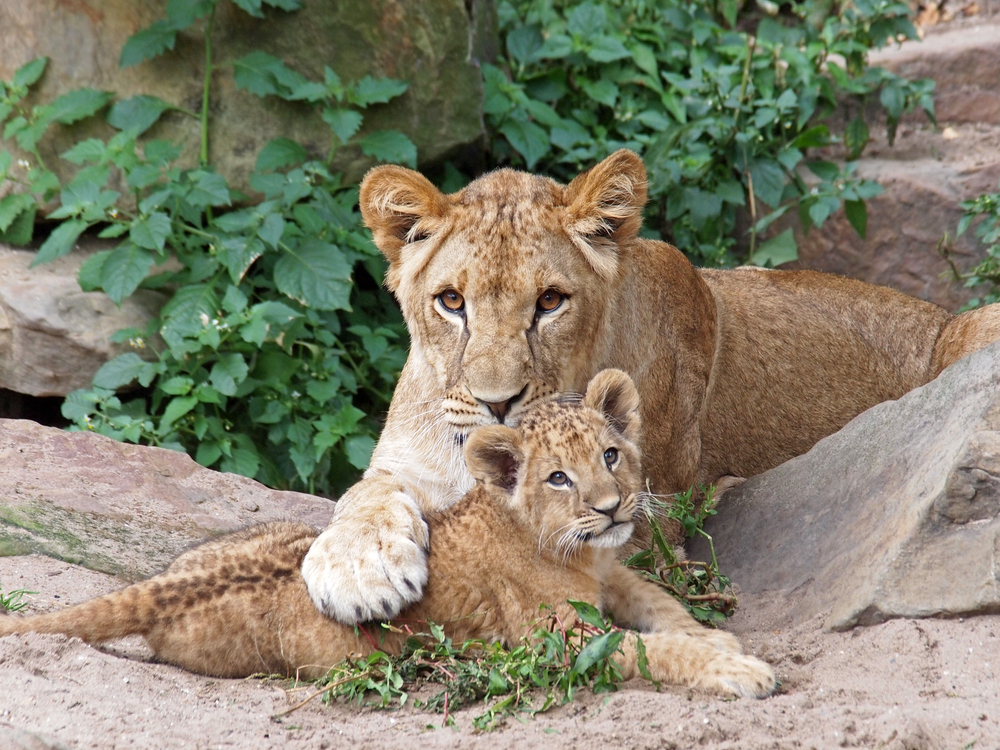What Animal Are You Most Like Project For Elementary Students

Mother King of beasts & Cub
All kids love babies—although big kids might not desire to admit it. This makes oohing and aahing over leggy lambs or tiny tadpoles and other infant animals a perfect segue into several related science topics, including life cycles, survival strategies, and inherited traits. Since babies really need no farther introduction, we'll jump correct into the activities!
Life Cycles
All living things on globe have i affair in mutual—a life cycle that starts with nativity, continues with growth and and then reproduction, and ends with death. What I like about this topic is that information technology can be accessed past very immature children, who might explore very simple life cycles like puppies and ladybugs, simply information technology can exist made very challenging for older students, who tin can explore the unusual life cycles of creatures like cicada and jellyfish.
Activity: Baby Matching
You will need:
• Photo cards of animate being babies and parents, enough for each pupil in your class to have one menu (if yous take an odd number of students, count yourself too!) OR
• Photo cards of life cycle stages (ranging from young/adult for most vertebrates to egg/larvae/pupa/adult for many insects).
Instructions:
1. Mix upwardly the cards.
two. Pass out the cards, one per educatee.
3. Have students move nigh the room until they locate their match(es). You might desire to designate an expanse for students to go after they have located their matching card(s).
four. Have students share their sets, giving their classmates an overview of that animal's life bicycle.
Note: Tailor these to your audition—piece of cake matches for young students, harder ones for older students. Run into links at the end of the commodity for image resources.
Activeness: Life Bicycle Posters
Assign each pupil an brute or have them choose. Invite them to create a poster showing the life wheel of that fauna. Younger kids tin tackle the classics, like frogs and ladybugs. Have older students challenge themselves a bit and cull a less common animal.
Survival Strategies
Amidst animals, there are widely ranging levels of parental care, from fretting over them for 18+ years before launching them into the world to laying eggs and leaving young to fend for themselves.
Some animate being parents have unusual or extraordinary strategies for protecting their young. For example, Arowana (fish) fathers are mouth brooders. They protect their young from predators by holding them in their mouths.
Baby animals also have ways to signal their needs to their parents. Many babe birds accept brilliant spots in their mouths that scream "place nutrient hither" to the parent. Some babe animals have to be scrappier than others to survive. Infant komodo dragons climb copse to avert predators that may include their own parents!
Activity: Protective Parents, Tough Babies
Talk over the ways that humans protect and care for their young and the signals human babies/children employ to communicate their needs to their parents. Have students choose either an amazing protective parent or a surprising tough infant and share about information technology in a brusk report, a poster, or a presentation to the grade. You might want to accept a list of possible choices to straight students to some of the more interesting creatures.
Inherited Traits
About babies are not exact copies of their parents, which ways they accept some differences, however slight. This chat tin begin at the earliest elementary levels with conversations about the fact that children practise not await exactly like their parents or that the new kittens in the business firm don't wait like their mom or dad. By the center of simple school, students tin begin to tackle more challenging topics, like dominant and recessive genes.
Activeness: "Do I Wait Like Mom & Dad"
You volition demand:
• Photos of brute parents and their young
Instructions:
1. Have students study the pictures of beast babies and their parents.
ii. Enquire "what is different about the babies and the parents?"
3. Extend the do by discussing how students await the same and dissimilar from their parents/guardians. (Be sensitive to kids who don't live with biological parents.)
Annotation: You could pair this activity with the Infant Matching activity. The focus of this activity is inherited traits, not stages in a life cycle, so limit the photo pick to young that do look similar their parents, just not exactly alike (east.yard., the young are smaller, accept different markings, accept slightly different features, etc.).
Online Resources for Life Cycles Activities
• Babe Animals Preschool Pack, a gratis resource from homeschool blogger i + i + 1 = 1 you tin can apply to make animal babies/parents cards.
o http://www.1plus1plus1equals1.com/PreschoolPackBabyAnimals.html
• "Color the Creature Life Cycles" worksheets, from didactics.com (This site requires yous to sign up, but it'due south gratis.)
o http://www.education.com/slideshow/color-the-animal-life-cycles/
Online Resources for Survival Strategies Activities
• "Father's Day Pictures: 'Best' Animal Dads," from National Geographic
o http://news.nationalgeographic.com/news/2009/06/photogalleries/fathers-twenty-four hours-2009-creature-dads-pictures/
Online Resources for Inherited Traits Activities
• "Genetics Beginner," an activity for Grades three-4 from Scientist Teacher Education Partnership Programme
o https://world wide web.teachervision.com/goggle box/printables/geneticsbeginnerext.pdf
• "An Inventory of My Traits," a classroom activity for Grades 5-vii from University of Utah's Genetic Science Learning Eye
o http://www.usc.edu/org/cosee-west/AprilLectureMaterials/Activities/AnInventoryofMyTraits.pdf
Source: https://kidsdiscover.com/teacherresources/baby-animals-science-lesson/
Posted by: readingharays.blogspot.com

0 Response to "What Animal Are You Most Like Project For Elementary Students"
Post a Comment